What is Markdown?

Created by Jordan Muller on 2024-06-01
What is Markdown & What Is It Used For?
Markdown is a lightweight markup language with plain text formatting syntax, designed to be easy to read and write. It is often used to format readme files, for writing messages in online discussion forums, and to create rich text using a plain text editor. Let’s explore its various aspects:
Basics of Markdown
- Markup Language: Markdown is not a programming language but a markup language that uses simple syntax to format text. It converts plain text into HTML.
- Simplicity: Markdown’s syntax is simple and easy to learn, making it an excellent choice for those who want to create formatted text quickly and efficiently.
Core Elements of Markdown
- Headings: Markdown uses
#symbols to create headings. For example,#for a top-level heading,##for a second-level heading, and so on. - Emphasis: Text can be emphasized using asterisks or underscores. For example,
*italic*or_italic_for italics, and**bold**or__bold__for bold text. - Lists: Markdown supports both ordered and unordered lists. Unordered lists use dashes, plus signs, or asterisks (
-,+,*), while ordered lists use numbers followed by a period. - Links: Links are created using square brackets for the text and parentheses for the URL, like this:
[example](http://example.com). - Images: Images are similar to links but include an exclamation mark before the brackets:
.
Importance of Markdown
- Ease of Use: Markdown’s straightforward syntax makes it easy to learn and use, even for those with no technical background.
- Portability: Markdown files are plain text, which makes them portable and easy to transfer across different systems and platforms.
- Versatility: Markdown can be used for various purposes, from writing documentation and creating web content to drafting blog posts and emails.
Advanced Features
- Tables: Markdown supports the creation of tables using pipes and hyphens to define columns and rows.
- Code Blocks: Code can be formatted inline using backticks (`), or as a block using triple backticks (```) for longer code snippets.
- Blockquotes: Blockquotes are created using the greater-than symbol (
>), making it easy to add quotes or call-out text.
Learning Markdown
- Beginner-Friendly: Markdown is designed to be easy to read and write, making it accessible for beginners who want to format text without delving into complex markup languages.
- Resources: Numerous resources, such as the Markdown Guide, GitHub documentation, and various online tutorials, are available to help users learn Markdown.
Conclusion
Markdown is a versatile and user-friendly markup language that simplifies the process of formatting text. Its plain text format ensures portability and ease of use, making it a popular choice for writers, developers, and content creators. Whether you’re drafting a document, writing a blog post, or creating a readme file, Markdown offers a straightforward and efficient way to produce well-structured and visually appealing content.